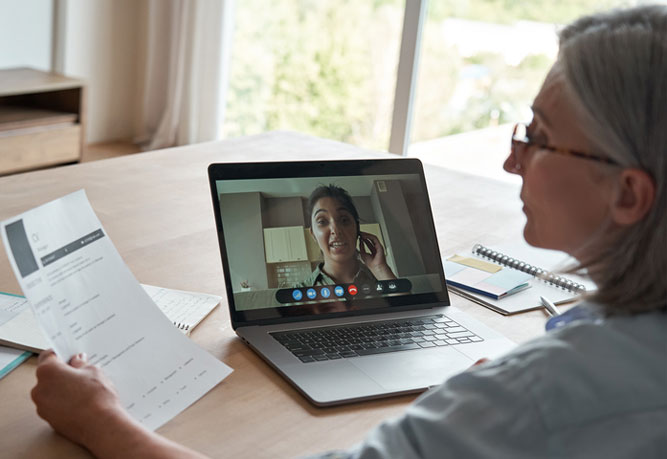As pandemic concerns linger, many companies are still operating in a hybrid way and “Zoom fatigue” is on the rise. Meeting via Zoom has become a common everyday experience for employees located literally around the globe. The tool has been a much-needed aid during the pandemic, but it’s not always used as effectively as it could be. Here we take a look at some do’s, don’ts and best practices for using Zoom most effectively when conducting hybrid meetings.
“Planning a virtual meeting is not a case of send your link, log on and go for it,” says Richard Ford, co-founder of Hart Accounting Services, an outsourced financial services provider based in Ontario. As with any meeting, it takes planning and preparation—in this case with thought given to the differences and idiosyncrasies of the digital environment.
Know the Technology!
It may go without saying, but we’ll say it anyone—know the technology that’s being used for the meeting. Don’t leave anything to chance. This is true whether you’re the meeting facilitator or an attendee. Meeting organizers should send out instructions ahead of time and practice with the technology in advance. Meeting participants should also make sure they can log into the technology with no problem and that they understand its features.
Organizations can aid in this process by preparing tip sheets or instruction guides that are readily accessible online for employees wherever they may be located.
Consider Branding
In a live meeting setting you would obviously be concerned with your surroundings and want to create the best impression, especially when meeting with prospects and clients. But even employee meetings can benefit from a professional setting—and consistency in various brand elements.
The same is true in a virtual environment, whether you’re holding or attending the meeting.
“Keep it simple and business oriented,” Ford advises. “As much as you may love to look like you’re on a beach in Hawaii, this isn’t professional, and is not suitable for a corporate meeting.”
Show Up Early and Respect Attendees’ Time
In the virtual meeting work, being on time isn’t good enough.
“Never be late to a meeting,” says Ford. “Rather, be a few minutes early to settle in, test your audience and video, and be ready” for the call.
Adam Luchs is sales director at Toast of the Town, LLC, an event services firm. For meeting organizers, Luchs recommends planning the meeting for either the start or end of the day. “Don’t hijack their entire day,” he advises. In addition, he suggests, keep the meeting concise and keep it on schedule. As people are showing up to the meeting, he suggests paying background music. This can help people know they’re in the right place and that their sound works, he says.
Have a Cameras On Policy
While there is much debate about this rule, many elearning and virtual meeting experts favor having a rule that participants must have their cameras on during the meeting.
Scott Winstead explains why. Winstead is the founder of MyeLearningWorld.com where he covers eLearning tools and software, remote work and virtual conference software.
“Attendees will be more likely to pay attention if they know others can see them,” he says. “If cameras are off, attendees will be more likely to attempt to multi-task, hold side conversations, and even walk away.”
One of the concerns about using cameras is that some people may feel that their privacy is being compromised since they’re often participating from home. However Zoom and other platforms have options to use alternatives backgrounds, or to blur the background so that this isn’t an issue.
Pay Attention to the Details
In a hybrid world, where people are located in different places, odds are good that they’ll be participating from different time zones. “A meetings’ time zone should always be mentioned clearly, since managers may be in another city or another country which can cause a lot of confusion,” says Cathy Mills, director of strategy with Net Influencer.
Mills notes that she has experienced situations where people have not connected for the meeting—”not because they were unaware of the meeting, but because their calendars were programmed for a different time zone,” she says.
Just being prepared, in general, is an important best practice Mills says. “Getting prepared is my number one recommendation for successfully planning a virtual meeting. If you have lost track of how many meetings you have already conducted, it is still important that you prepare and have a structure before each meeting. Specifically, it means the topics to be discussed, the timeframe, questions to be asked, and any application to be used during the meeting.”
Consider Using a “Meeting Monitor”
Having someone to help with the administrative tasks and troubleshooting for virtual meetings can help things flow more smoothly and provide a better experience for attendees. Luchs refers to this individual as an “event concierge.”
Mills agrees. Managing multiple people who may either be in person or online in a variety of locations can present challenges for the facilitator and distract both the facilitator and meeting participants. Instead, suggests Mills: “Especially at the beginning of a meeting with a large number of people, having someone who will monitor attendance, make sure microphones are off, make sure cameras are on, and worry about any technical problems privately is vital.”
A moderator, or event concierge, can also help to trouble shoot any technical issues that may come up—and chances are, they will. “Having one person in charge of this will be very important since one problem could affect the entire meeting,” says Mills. “If this is handled by one person, it will make the meeting much simpler.”
Finally, a meeting monitor can also help to make sure that everyone has an opportunity to engage and contribute, manage breakout rooms and other tech tools like screen sharing, polling, etc.
Winstead recommends using Zoom’s polling feature. “It allows you to ask questions and provide multiple choice answers, which can be great not only for feedback, but also to get attendees to interact with you. That interaction require they pay attention.”
Virtual meetings are here to stay and, in many ways, they represent great benefit to organizations of all kinds. It pays to be prepared, though, whether facilitating or participating in online meetings. Following these simple tips and implementing proven best practices can help.



